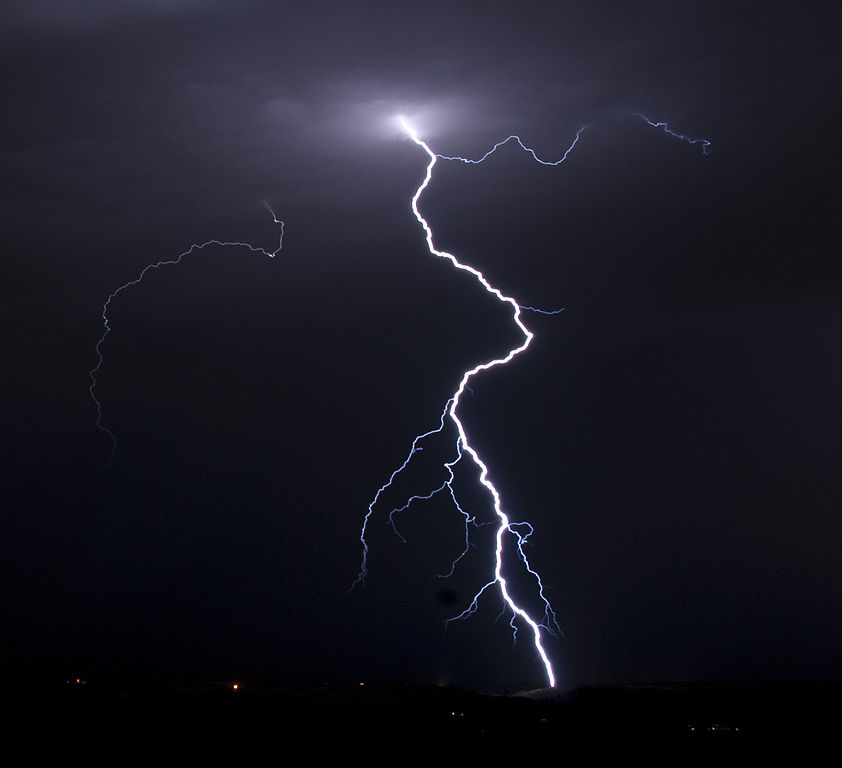Almanac: Winter Thunder

Photo: Creative Commons
The sun had long since set by the time a friend and I started climbing Mount Holyoke about 10 days ago. It was cloudy and very dark, but the southerly air was mild. Neither of us had checked the weather forecast before heading out. We were surprised, therefore, when the wind picked up and it started raining heavily. Then we were startled by the flash of lightning and the hard crack of thunder. Really? A thunderstorm? In December?
We had rain gear, and we weren’t so high on the mountain that the lightning posed any serious threat, so we chose to continue, although the time separation between the flashes and the thunder was decreasing, meaning the center of the storm was approaching rapidly.
Thunder and lightning in December is relatively rare because the engine of thunderstorms is heat. In summer, rising columns of hot, moist air can form cumulonimbus clouds reaching beyond 30,000 feet. As the air cools inside the thunderheads, the water condenses, forming rain and frozen rain of various sizes.
Curiously, the precise mechanisms by which electrical charge gets separated inside a thunderhead is still not fully understood. The basic idea, however, is that the ice particles within the cloud collide, fracture, and break apart. It is thought that the smaller particles tend to acquire a positive charge and rise on the strong updrafts, while the larger particles acquire a negative charge and fall by gravity to lower elevations.
This separation of charge produces an electrical potential of millions of volts, both within the cloud and between the cloud and the ground. Eventually the electrical resistance of the air, which acts as a fairly decent insulator, is overcome and all of that static charge is released in milliseconds. A lightning flash is actually composed of a series of strokes (the average is four). (Check out this very cool look at the formation of a lightning strike recorded with an ultra-high-speed camera.)
A typical lightning bolt has a diameter of 1-2 inches and heats the surrounding air to about 70,000° F. The violent increase in temperature causes the air to expand faster than the speed of sound (think of a sonic boom). The sound travels at 758 mph, or 1,130 feet/second, which is why you can roughly gauge how far away a storm is by counting the seconds between the flash and the thunder: every 5 seconds corresponds to about a mile of distance.
The thunderstorm we were caught in occurred because there was a mass of relatively warm (in the low 50s) moist air over western Massachusetts that day. A cold front approached from the west. The cold air, being heavier, acted like a snow shovel or a wedge, pushing the warm air up with enough force and energy that thunderstorms formed along the boundary of the two fronts (although the thunderheads were probably not as tall as normal summertime storms). This happened even though the “warm” air wasn’t nearly as warm as a summer air mass.
If the cold front had been even colder, we might have experienced “thundersnow”—a storm with enough energy and charge separation to cause lightning, but with the precipitation falling as snow rather than rain. This is quite rare, but I’ve experienced it once, years ago. (This wasn’t the storm I remember, but on December 7, 1996, thundersnow in Worcester was caught on video during a Weather Channel segment.)
The storm blew over us fast and furious for about 20 minutes, and then it was gone. By the time we got up to the Summit House the combination of being sweaty and the now-cold, blustery wind impelled us to rest in the lee of the building. The clouds were low and scudding by fast. Some patchy fog lay below, blurring the lights of the surrounding towns. It would have been exciting to be on the Summit House porch during the height of the storm, but it was also fine being there post-storm listening to the wind as it whistled through the bare trees.
Almanac is a regular Indy column of observations, musings, and occasional harangues related to the woods, waters, mountains, and skies of the Pioneer Valley. Please feel free to comment on posts and add your own experiences or observations.

1 thought on “Almanac: Winter Thunder”